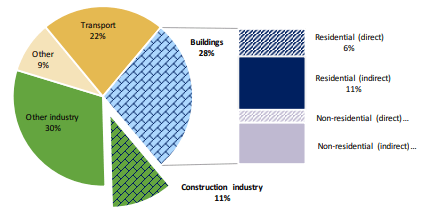
(Global energy-related CO2 emissions by sector in 2015) (Abergel et al., 2017)
We live in countries that are constantly developing and it is inevitable to witness many construction sites around us. In Singapore, due to land scarcity, it is common to see many new constructions of Housing Development Buildings(HDBs) which are flats, to accommodate many residents. In 2019, construction has contributed to 3.7% of Singapore’s Nominal Gross Domestic Product amounting to around $507 billion (Department of Statistic Singapore, 2020).

(HDB construction sites in Singapore) (Long, 2019)
With reference to the chart above, here are some sources of air pollution in construction:
Extraction of natural resources for making construction materials.
Burning of resources such as limestone to make cement.
Burning of waste materials (Li et al., 2010; Morel et al., 2001).
These sources not only require huge energy consumption but produce pollutants (Eg the release of chemical impurities like heavy metals, carbon monoxide, nitrogen oxides, PM 10 from dust particulates, and PM 2.5 from smoke as a result of burning) (Gray, 2020; Dezem, 2019; Esa & Rahman, 2014).
Construction is not limited to only buildings and infrastructures, but also roadworks and the pollutants it produces (such as PM 10) are also similar. (Baker et al., 2014) Remember us talking about the health and environmental effects of such pollutants? This is why this topic on construction is exceptionally critical to us who are living in developing or developed countries because almost everywhere around us, we are surrounded by construction sites, and each construction takes a few years to complete. Take a moment to imagine the long term effect it has on us.
Personally, I tend to be sensitive whenever I see construction sites around. Mainly because I am a nature lover and the birth of a construction site would mean that our precious trees to capture carbon are gone…As more and more trees and vegetation gets replaced, the more I feel upset because what we are doing is getting rid of our carbon sink and bear in mind that NO amount of sustainably built buildings would function the same as our carbon sinks.
Though I do recognize that there are some efforts by innovators such as coming up with carbon-free ideas of making cement, which is really impressive (Rodgers, 2018)! In reality, the uptake rate of new solutions is slow due to concerns over higher cost and reduction in productivity. It is understandable that as much as producers or construction project planners would like to go for the more sustainable and eco-friendly way of operating their business, the important question would be, who would bear the additional cost for choosing greener options? With that being said, it is certain that the government plays an important role which is not only to enforce stricter rules to reduce emissions but also to provide more subsidies to construction projects to reduce their carbon footprint during construction.
Your environmental buddy,
Zhi Yong
References:
Department of Statistic Singapore. (2020, July) Singapore Economy. Retrieved from https://www.singstat.gov.sg/modules/infographics/economy
Dezem, V. (2019, June 23). Cement produces more pollution than all the trucks in the world. Retrieve From https://economictimes.indiatimes.com/news/international/world-news/cement-produces-more-pollution-than-all-the-trucks-in-the-world/articleshow/69919005.cms?from=mdr
Esa, N. & Rahman, N. N. (2014). Managing Construction Development Risks to the Environment. Sustainable Living with Environmental Risks, 193-202. doi:10.1007/978-4-431-54804-1_16
Baker, T., Font Font, A., Fuller, G., & Mudway, I. (2014, May). Road construction: Emissions Factors and Air Quality Impacts. Retrieved from https://ui.adsabs.harvard.edu/abs/2014EGUGA..1611243F/abstract
Gray, J. (2020, August 16). Pollution From Construction. Retrieved from http://www.sustainablebuild.co.uk/pollutionfromconstruction.html
Li X., Zhu Y. and Zhang Z. (2010), An LCA-based environmental impact assessment model for construction processes. Building and Environment, 45(3):766-775.
Long, J. (2019, August 21). HDB sales exercise pushed to September so buyers can benefit from upcoming changes: Lawrence Wong [Digital image]. Retrieved from https://www.channelnewsasia.com/news/singapore/hdb-bto-august-sales-exercise-pushed-september-lawrence-wong-11827238
Morel J. C., Mesbah A., Oggero M. and Walker P. (2001), Building houses with local materials: means to drastically reduce the environmental impact of construction. Building and Environment, 36(10):1119-1126.
Abergel. T, Dean. B and Dulac. J. (2017). Global Status Report 2017 [Brochure]. Author. Retrieved from https://www.worldgbc.org/sites/default/files/UNEP 188_GABC_en (web).pdf
Rodgers, L. (2018, December 17). Climate change: The massive CO2 emitter you may not know about. Retrieved from https://www.bbc.com/news/science-environment-46455844
